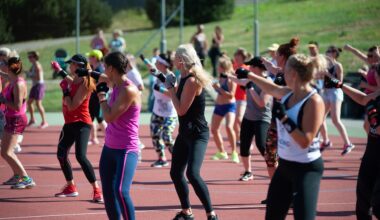How Chronic Inflammation Impacts Muscle Recovery and Performance
Chronic inflammation is a condition that can significantly reduce muscle recovery and athletic performance. It occurs when the body’s immune response is continuously activated, leading to the release of inflammatory cytokines. These cytokines disrupt muscle repair mechanisms and hinder protein synthesis, essential for muscle growth and recovery. As athletes and fitness enthusiasts, understanding the impact of chronic inflammation helps us manage our bodies effectively. This condition can arise from various factors, including inadequate sleep, poor nutrition, stress, and even overtraining. Identifying its causes is crucial in mitigating its effects. In this context, adopting a balanced diet rich in antioxidants, such as fruits and vegetables, can help combat inflammation. Foods like berries, leafy greens, and nuts play a vital role in reducing inflammatory markers in the body. Physical activity also serves as a natural anti-inflammatory agent. Engaging in regular, moderate exercise may enhance recovery by promoting better circulation. Ultimately, recognizing and addressing chronic inflammation is necessary for anyone looking to improve their athletic performance and ensure quicker muscle recovery after intense workouts.
Inflammation can significantly impact muscle recovery through various biological pathways. When inflammation is persistent, it leads to increased oxidative stress, which can damage muscle cells and inhibit the healing process. Research indicates that elevated levels of certain inflammatory markers correlate with decreased muscle protein synthesis. This phenomenon can result in prolonged soreness and greater muscle damage. Furthermore, chronic inflammation can alter hormonal balance, notably increasing cortisol levels while decreasing testosterone. These hormonal changes can further impair recovery and muscle growth. Continually high cortisol levels are linked to catabolism, where muscle tissue is broken down for energy, counterproductive to fitness goals. To mitigate these effects, athletes should prioritize strategies for inflammation management. Proper hydration is essential, as it helps flush out toxins and supports cellular repair processes. Techniques such as foam rolling or massage can also enhance blood flow and promote recovery. Moreover, incorporating practices like yoga or meditation can help manage stress, reducing cortisol levels and thus inflammation. In essence, adopting a holistic approach that combines good nutrition, adequate sleep, and stress management is vital for combating chronic inflammation.
The Role of Nutrition in Inflammation and Recovery
Nutrition plays a pivotal role in managing inflammation and enhancing muscle recovery. Consuming an anti-inflammatory diet can accelerate healing, allowing athletes to return to peak performance more quickly. Essential fatty acids, particularly omega-3s, found in fatty fish like salmon and walnuts, are known for their anti-inflammatory properties. These fats can reduce the production of inflammatory cytokines, improving recovery times. Additionally, whole grains and legumes are rich in fiber, which has been associated with lower levels of inflammation. Coupled with adequate protein intake from sources like lean meats, dairy, and legumes, these nutrients contribute to optimal muscle repair. It is also crucial to avoid pro-inflammatory foods. Processed sugars, refined carbohydrates, and trans fats can increase inflammation and hinder recovery. Supplements like curcumin and omega-3 fatty acids may also provide additional support in reducing inflammation. It is essential, however, to consult a healthcare professional before introducing any supplements. Reducing inflammation effectively through diet facilitates better performance in training and competitions. Therefore, athletes should continually reassess their nutritional strategies for effective management of inflammation.
The timing of nutrient intake plays a substantial role in enhancing recovery and managing inflammation. Consuming protein and carbohydrates shortly after exercise can initiate recovery processes by promoting muscle glycogen resynthesis and stimulating protein synthesis. This immediate intake can help mitigate the inflammatory response triggered by intense physical activity. Incorporating antioxidants into post-workout meals can also assist in neutralizing free radicals produced during strenuous exercise. Foods rich in vitamin C, such as oranges and berries, or vitamin E sources, like nuts and seeds, play a vital role here. Furthermore, hydration must not be overlooked; it supports metabolic processes and maintains cellular function. A well-hydrated body experiences improved nutrient delivery to muscles and efficient waste removal, both critical for recovery. On the other hand, dehydration exacerbates the inflammatory response and can prolong recovery. For optimal hydration, athletes should monitor their fluid intake based on their activity levels and environmental conditions. Strategies like electrolyte drinks may also aid in recovery, replenishing essential minerals lost through sweat. In summary, careful planning around nutrition timing and hydration can significantly improve recovery outcomes and reduce inflammation.
Physical Activity and Inflammation
Engaging in physical activity is a double-edged sword regarding inflammation and muscle recovery. While exercise is essential for overall health and fitness, intense or prolonged workouts can trigger inflammation. This is particularly true for high-impact activities and heavy lifting, which cause muscle micro-tears. However, regular moderate exercise ultimately acts as an anti-inflammatory agent. Studies have shown that consistent physical activity can lead to reduced overall inflammation levels, improving recovery rates. The key is finding balance; alternating between high-intensity training and recovery-based activities can help mitigate excessive inflammation. Active recovery tactics, such as light jogging or swimming, keep blood flowing to muscles without over-stressing them. Furthermore, strength training can enhance muscle resilience against inflammation by building larger muscle fibers that can better absorb stress. Incorporating strength training into a workout regimen can slow the catabolic effects of chronic inflammation. Recovery strategies such as cool-down exercises and stretching also contribute to reducing inflammation. Thus, understanding the relationship between exercise and inflammation, along with implementing recovery strategies, is crucial for preventing performance setbacks.
Injuries and chronic conditions like arthritis or tendonitis, often linked to chronic inflammation, can disrupt muscle recovery and performance. These conditions can become particularly challenging for athletes looking to maintain peak performance levels. Inflammation at these sites delays healing time and can lead to chronic pain, making it difficult to train effectively. The recovery process often necessitates a multifaceted approach, incorporating physical therapy and functional strength training to promote healing. Furthermore, modalities such as cold therapy or anti-inflammatory medications may assist in managing symptoms while aiding recovery. It is also essential to be aware of the warning signs of chronic inflammation, as early intervention can prevent long-term impacts on health and performance. Ignoring symptoms like persistent pain or swelling may lead to worsening conditions. Athletes should consult healthcare professionals for evaluations and develop personalized treatment plans based on their needs. Additionally, injuries can result in a decrease in activity levels, further exacerbating inflammation. Sticking to a well-rounded rehabilitation program that includes rest, but also gradual reintegration of physical activity, is vital for effective recovery.
Final Thoughts on Inflammation Management
In conclusion, managing chronic inflammation is paramount for optimal muscle recovery and athletic performance. Individuals should be proactive in addressing inflammation through lifestyle modifications, including diet, exercise, and recovery protocols. Regular assessments of one’s training routine can help identify potential areas of excessive stress on the body leading to inflammation. Recovery strategies such as proper nutrition timing, hydration, and active recovery can significantly enhance performance. Athletes also need to stay informed about their body’s responses to workouts, adapting their plans based on individual needs. Embracing mindfulness practices can greatly support physical recovery by reducing stress levels, which contribute to inflammation. Developing an awareness of inflammation’s role in workouts empowers individuals to train intelligently and sustainably. Ultimately, achieving a balance in active pursuits while allowing the body to recover and heal is fundamental. By prioritizing an anti-inflammatory approach to fitness, athletes can enhance their performance potential and enjoy a healthier relationship with their bodies. This journey offers the opportunity to unlock greater achievements in sports and overall well-being.


